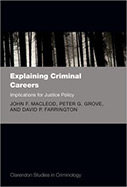Explaining Criminal Careers: Implications for Justice Policy
 Author: John F. MacLeod, Peter G. Grove, and David P. Farrington
Author: John F. MacLeod, Peter G. Grove, and David P. Farrington
Publisher: New York: Oxford University Press, 2012. 256 p.
Reviewer: Matt DeLisi | September 2013
In life, individual-level variation is seen in both positive and negative ways. In essentially all areas of human achievement, a relatively small number of individuals—about 5-10% or so—account for the majority of all productivity — whether that productivity is measured as publications, citations, points scored, championships, arrests, or convictions. The few produce much; most produce little. Similarly, a relatively small number of individuals often account for the preponderance of problems, challenges, or difficulties. Decades of research has shown this is particularly true in the case of crime.
In Explaining Criminal Careers: Implications for Justice Policy, John F. MacLeod, Peter G. Grove, and David P. Farrington address this issue in an impressive quantitative study of 100,000 offenders from seven cohorts selected from the Home Office Offenders Index. The authors raise several questions with critical implications for criminal career research and criminal justice/correctional policy in Chapter 1. These include how many categories of offenders exist, how categories of offenders differ in terms of individual offending frequency and probability of persistence, what factors explain the age-crime curve, how well parameters of the criminal career can be predicted, what the effect of imprisonment on offending reflects, and others.
Chapter 2 contains the heart of their analyses and describes several key findings. MacLeod, Grove, and Farrington report there are two categories of offenders, those who are low risk and offend at a low rate (most offenders are this type) and those who are high risk and offend at a high rate. They found no evidence of a low-risk, high-rate offending group. They found residual evidence of a high-risk but low-rate offending group (in the summary chapter, the authors acknowledge three groups of offenders: high-risk/high-rate, high-risk/low-rate, and low-risk/low-rate). Moreover, the authors reported that the proportion of offenders across cohorts is essentially constant, and that the proportion of offenders in each of the risk/rate categories is substantially constant across birth cohorts.
Chapter 3 establishes their theory of offending and prison effects. MacLeod, et al. report that the offending behavior of criminals is assumed to remain the same throughout their active careers, and is reduced only when offenders decide to cease offending after repeated convictions. They assert that the age-crime curve is more correctly reflecting the age-conviction curve, and that the dramatic upsurge in offending during late adolescence, peak, and then sharp decline simply reflects the increased use of formal sanctions that are applied to adults as opposed to children and adolescents. Thus, the age-crime curve really is a criminal justice response curve to otherwise constant offending behavior. Interestingly, the authors report that cohort declines in offending reflect the proportion that have chosen to cease offending, and do not reflect intrinsic reductions in the predilection toward offending. Put another way, prison wears down offenders to the point where they ultimately decide to desist—they do not transform their mindset. They do not choose to make good.
Chapter 4 examines the criminal careers of serious, less serious, and trivial offenders. This chapter largely validates many known findings in criminal careers research. Specifically, MacLeod, Grove, and Farrington report that those who commit the most serious forms of crime appear to be random, although crime seriousness is also correlated with high-rate offending. In terms of specialization and versatility, MacLeod, et al. report modest evidence for specializing in crime across consecutive offenses; instead the larger trend for all offenders is versatility.
Chapter 5 examines whether age is the primary influence on offending. The answer in a word is: no. These authors report no evidence that age explains declines in crime across adulthood. Instead, the authors found that the criminal justice system and its repeated convicting of offenders is the most important factor in reducing the number of active offenders in society. Chapter 6 examines the characteristics of various types of offenders in terms of lifestyle, thinking, and attitudes and finds differences discriminating high and low risk offenders.
Chapters 7, 8, and 9 address the criminal justice implications of their quantitative approach to criminal careers. They suggest that their approach allows for more accurate predictions of the size of the offender and prisoner population which facilitate the allocation of resources for crime control. They even include frequently asked questions/concerns about their theory and what their data show in terms of answering those questions. This is a conscientious feature that anticipates critiques of their theory. Finally, the appendix includes extensive mathematical and methodological information to help the reader digest the findings.
Explaining Criminal Careers: Implications for Justice Policy is a challenging read. The authors are expert methodologists and the book is very heavy with graphs, figures, formulas, and advanced statistics. Even seasoned quantitative researchers will have to closely read the book to capture its meaning. The low readability detracts from the possible impact of the book –particularly because of its policy focus and relevance. Lay readers will have difficulty with the statistical jargon and perhaps miss some of the important points that MacLeod, Grove, and Farrington are trying to make.
That criticism aside, Explaining Criminal Careers: Implications for Justice Policy is very thought-provoking, not only for its policy statements, but also its bold assessments of criminological theory. For example, because MacLeod, Grove, and Farrington report little evidence that age affects criminal careers, they similarly are critical of theories that utilize age as a causal explanation for behavior over the life course. This means that some of the most influential theories in the field are called into question. For example, they found no support for Gottfredson and Hirschi’s self-control theory, and similarly question life-course trajectory interpretations of criminal careers as evidenced by the work of Nagin, Land, Sampson, Laub, Moffitt, and others. And yet, MacLeod, Grove, and Farrington also draw parallels between their conceptualization of types of offenders, especially the high-risk, high-rate offender, and other typological approaches such as career criminals and life-course-persistent offenders.
On the policy front, there is pragmatism to MacLeod; et al.’s writing that is bold and refreshing. Most striking is their honest assessment of what the criminal justice system truly accomplishes. Criminologists probably hold an overly Pollyannaish view of offenders and their willingness and ability to change. Most offenders do not change, and instead are simply beleaguered by the judicial and correctional consequences of their antisocial conduct. This is especially true for the most high-risk offenders. In this way, the criminal justice system serves very important functions in terms of incapacitation and specific deterrence.
In the end, I found myself smiling at certain parts of Explaining Criminal Careers: Implications for Justice Policy and rolling my eyes at other parts. And that is a sure sign of a good book –it makes readers think.
Matt DeLisi, Professor and Coordinator of Criminal Justice Studies, Iowa State University


